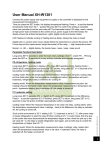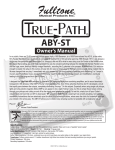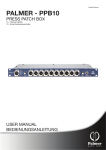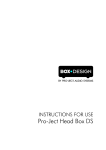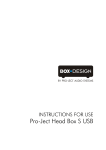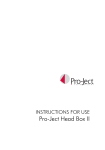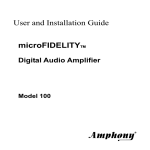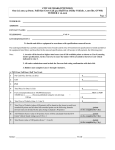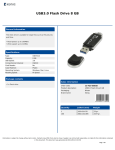Download 2B User Manual
Transcript
Congratulations on the purchase of your What is it? The Fulltone 2B is an amazing boost pedal, born from the “Boost” channel in our FD3 pedal. Soon after the FD3 came out I started getting a steady flow of emails asking if I could “please make that into a single channel Boost pedal!” So I crammed the circuit into the smallest possible enclosure 4.5" x 2.1" x 2.3" with battery tucked tightly inside and even engineered space-saving rear-mounted IN, OUT, and DC power jacks, and added an important feature not offered in the FD3. Why does a guitarist need a “Boost” pedal? A boost pedal is not only used to kick up your volume when it’s time for your solo! A good booster can also solve a lot of problems in the modern guitarist’s rig, because today’s pedalboards average 8 or more pedals, with each of those pedals requiring: a guitar cable--->jack-->more wire--->footswitch--->circuit--->footswitch again--->jack--->more wire--> and on to next pedal. It’s a wonder there’s any signal left after all the stuff we put our signal through. Ever played through a 10’ guitar cable straight into a great tube amplifier? The feel, the dynamics, the fat tone...makes you want to play! Then you connect to your overpopulated pedalboard and suddenly the sound is tiny, thin, with diminished lows, cardboard mids, and scratchy thin highs. This is where a good booster comes in handy, because all that wire and all those connections reduce your signal by a measurable amount with each passing effect in your signal chain. Add a good booster and you can recoup a lot of that lost gain, tone, and reactive interplay between you and your lovely tube amp. Suddenly the “touch” is back What happens when the 2B is turned OFF? That’s the problem with other boosters…once they’re OFF, they cease to offer a high quality unity-gain buffer to drive the long cables, so you end up having to buy TWO boosters, one set to “unity gain” and the other set to do your Volume changes! A better solution is the 2B, its unity-gain JFET amp buffers your signal when the pedal is turned OFF…and when the 2B is turned ON; the only difference is now the GAIN knob comes into play allowing you to set the desired boost up to 20dB! This is what differentiates the 2B from the FD3’s Boost Channel…the FD3 is true-bypass whereas the 2B has the added benefit of being buffered-bypass. Why is the 2B a great booster? Because I go the extra mile and buy the best JFET opamp, in my opinion….certainly the one that sounds the best to my ear. The problem with other boosters is that the more you turn them up, the more highs they add. Not the case with the 2B, there is a subtle roll-off of the harsh ultra-high frequencies as you roll the LEVEL knob clockwise past 12 o’clock. It’s subtle, you may not hear it, but you WON’T hear that shrill top end that other boosters can impart! What’s the DYNAMICS knob? The 2B offers something completely unique in the world of Boost pedals; a DYNAMICS knob. A subtle Germanium diode Limiter circuit that (as you turn the min-knob clockwise) starts to slightly alter the feel of the notes being played as well as subdue the harsh transient spikes which can overload your amp’s input. Those spikes can be fatiguing to your ears, to the amp, and to its speakers! Similar to using a limiter on the mix down of a song in the studio, the 2B’s DYNAMICS feature helps you keep your place in the live mix.....like a very smart compressor. This feature can make even an “ok” amp feel responsive and juicy, and will keep you from distorting the amp’s input, a problem plaguing most booster pedals. Enjoy your new Fulltone 2B! Michael Fuller / President 2015 FMP Inc. Manual Version 1.0 Page 2 9 3 8 2 1 6 IN Jack (#1 on above diagrams): Plug a cable (shielded with ¼” mono plugs) coming from the instrument (or from the OUT of other effects) into this jack. Always use good quality shielded cables (e.g. Fulltone Gold Standards) for audio signals, speaker cables are un-shielded and should never be used. 7 5 OUT Jack (#2): Connect a cable (shielded with ¼” mono plugs) going to your amplifier and/or the IN of other pedals. DC Power Port: (#3) You may run this device on a 9 volt battery (included), a high-quality, 4 regulated 9 to 18VDC wallwart (not included), or high-quality 9-18VDC regulated pedalboard powersupply. The power cable’s center must be configured to the (industry-standard) 2.1mm x 5.5mm barrel plug with Negative to Center Pin configuration, as per following diagram: The Fulltone FPS-1 (not included) is a great 9VDC regulated power adapter. If you’d like to experiment with what 18VDC can do, I highly recommend the Fulltone FPS-3, both adapters are available direct through our website. (US customers only) ON/OFF footswitch (#4): use this switch to turn the GAIN “boost” function on or off. When the LED (#5) is lit, you can adjust the volume “boost” using the GAIN knob. (#9) When the pedal is switched OFF, the pedal becomes a high-quality “unity gain buffer,” meaning it is NOT True-Bypass. Instead, the 2B’s great sounding JFET buffer completely alleviates the signal & tone loss brought on by other effects in the chain with poor audio circuity, the use of patch cables, long lengths of cable going from the guitar, all through the pedalboard, and on to the amp. I am a huge proponent of “True Bypass” effects, but ONLY if a high quality “buffer” is present at all times somewhere in the signal chain to counter all of the tone-sucking that is inevitable with so many connections. Fuzz pedal tip: place the 2B AFTER any fuzz pedals so that the 2B’s ultra-low output impedance won’t affect the Fuzzes sound...Fuzz pedals like to see high impedance signal, like that coming straight from your guitar! BATTERY: The 2B ships with a 9 volt carbon-zinc battery located inside the pedal. To access the battery, remove the left & right side thumbscrews (#6 & #7) by turning them CCW, separate the top & bottom sections of the pedal, replace battery, and reassemble the pedal. GAIN knob (#9): This knob is only active when the LED (#5) is lit. Turn Clockwise (CW) and the volume will increase...turn it Counter Clockwise (CCW) and the volume will decrease. When set to full-CCW the level should be almost identical to when the pedal is switched OFF. The amount of available GAIN boost is dependent on many factors, one of which is how powerful and healthy your amp is, and how much available headroom your amp’s input has to offer. If using lower wattage amps, the sound may not only get louder, but it may cause the amp to distort so be aware that a distorted signal may not be the fault of the pedal, rather it might mean that your amp does not have enough available headroom and is distorting. There are many variables that determine available headroom; health and type of Tubes used, as well as speaker condition and even amp design also come into play. DYNAMICS knob (#8): This knob is functional when the 2B is turned ON. Turning this knob CW will start to bring in a subtle Germanium diode limiter circuit, there is no right or wrong way to use this, choose your setting based on how it makes the notes feel when you pick the strings. WARNING! If you turn this knob too far CW it will actually start reducing your volume, just like a studio Limiter/Compressor can do. Use taste when setting this function, I find that the ideal way to set this is to first set the DYNAMIC knob to the desired feel, and then adjust the GAIN knob to desired volume. SPECIFICATIONS: Input Impedance: is an ultra-high 1.65mega ohms…eliminating interaction issues with guitars or other effects coming before your 2B Output Impedance: ultra-low 300ohms..no chance of loading or interaction issues. Max Gain: @ 20dB Size: 4.5" x 2.1" x 2.3" Weight= 12 ounces (with the included battery) Power requirements: anything from 5 to 18 volts DC, 9 or 18 VDC recommended. Warranty: Fulltone products carry a Limited 5 year Warranty to the original owner with proof of purchase that the product was bought from an Authorized Fulltone Dealer. There is no need to register your product, simply keep a copy of your original sales receipt. The Warranty covers failure due to manufacturing errors only and is void if any mod or repair is performed by anyone other than Fulltone AND/OR if we deem that any operator-caused abuse or damage has occurred, for example; the use of an incorrect power supply, a dropped pedal, water damage, etc. Customer is always responsible for all shipping costs both to and from Fulltone. Do not attempt to call Fulltone, instead, all Repair issues are handled via email to troubleshoot the possible problem and (after troubleshooting) for the scheduling of Warranty Repair. After we have deemed that a repair is necessary, we will email you an Acrobat PDF copy of our Return Authorization Form (RA Form) and print it out, fill out all information, and include it with the device you are sending. Fulltone Musical Products Inc. is not responsible for and injuries and/or damages related to the use of our products. 2015 FMP Inc. All Rights Reserved Fulltone Musical Products Inc. 11018 Washington Blvd. Culver City, CA 90232 for more info and expanded information & videos go to www.fulltone.com Sales related questions email [email protected] Repairs/Technical related questions go here http://www.fulltone.com/contact/fulltone-repair-process



